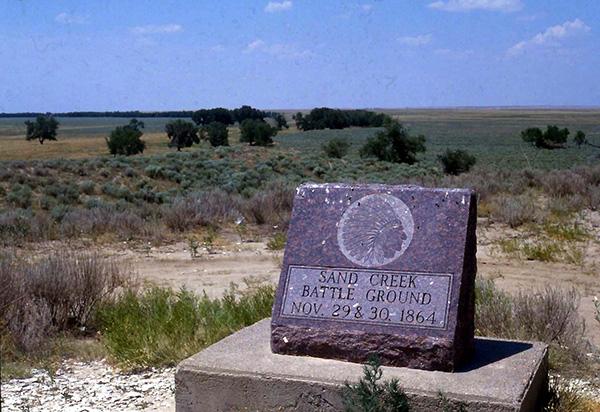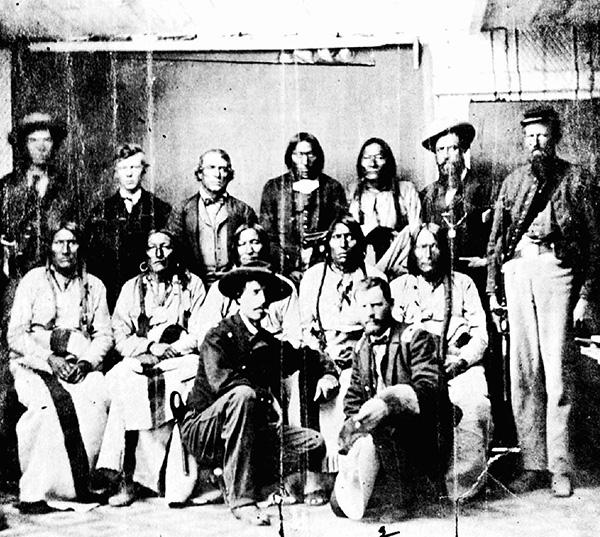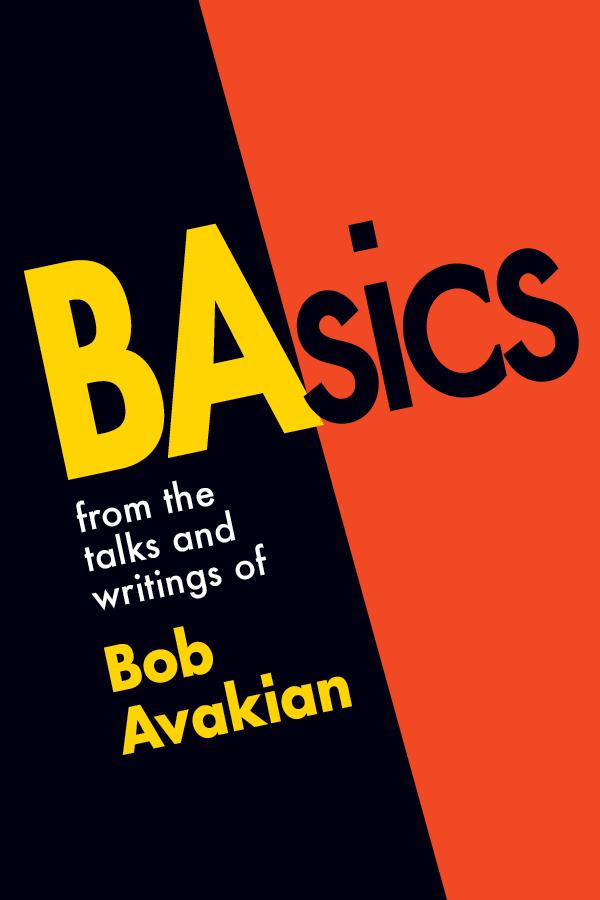Bob Avakian has written that one of three things that has “to happen in order for there to be real and lasting change for the better: People have to fully confront the actual history of this country and its role in the world up to today, and the terrible consequences of this.” (See “3 Things that have to happen in order for there to be real and lasting change for the better.”)
In that light, and in that spirit, “American Crime” is a regular feature of revcom.us. Each installment focuses on one of the 100 worst crimes committed by the U.S. rulers—out of countless bloody crimes they have carried out against people around the world, from the founding of the U.S. to the present day.
See all the articles in this series.


The site of the Sand Creek Massacre. Photo: Wikimedia Commons
THE CRIME:
They came at dawn, November 29, 1864, 700 heavily armed soldiers of the 3rd Colorado Cavalry, led by Colonel John Chivington. They rode rapidly toward their target, a Cheyenne village near Sand Creek, where the people were caught by surprise because months earlier, representatives of the U.S. government had met with their chief, encouraged him to settle near the creek, and had promised him and his people peace and safety. As the soldiers approached, the chief, Black Kettle, raced to raise the American flag over his lodge in a show of solidarity; others raised white flags of surrender. It didn’t matter.
The soldiers opened fire with carbines and cannons, killing at least 130, almost two-thirds women, children, and the elderly. Most of the young men were out hunting when the attack occurred; otherwise, the death toll would have been considerably higher. Before leaving, the soldiers burned the village and mutilated the dead.
Captain Silas Soule, a passionate anti-slavery abolitionist, was appalled by the attack, which he saw as a betrayal of the agreement between the U.S. government, Colorado authorities, and Black Kettle. Soule refused to fire a shot or order his troops into action, instead bearing searing witness to the massacre. “Hundreds of women and children were coming toward us, and getting on their knees for mercy,” Soule wrote, only to be shot and “have their brains beat out by men professing to be civilized.” Soule estimated that 200 were killed, all but 60 of them women and children. He also described how the soldiers not only scalped the dead but cut off the “Ears and Privates” of some.


At a “peace council” at Camp Weld on September 28, 1864 (before the Sand Creek Massacre), between Cheyenne and Arapaho tribal leaders and Governor Evans and Colonel Chivington. The photo includes Chief Black Kettle and Captain Silas Soule. Photo: Wikimedia Commons
Another appalled witness said: “I saw bodies of those lying there cut all to pieces, worse mutilated than any I ever saw before; the women cut all to pieces ... with knives; scalped; their brains knocked out; children two or three months old; all ages lying there, from sucking infants up to warriors...”
Colonel Chivington and his troops dressed their weapons, hats, and gear with scalps and other body parts, including the breasts they had sliced off and the vaginas they had cut out. They also publicly displayed these “battle trophies” in Denver’s public theater during intermissions, as well as at area saloons.
THE CRIMINALS:
The U.S. Government: The Cheyenne and Arapaho peoples had been guaranteed ownership of a large territory in eastern Colorado by the 1851 Treaty of Fort Laramie. But in 1858 waves of white immigrants flooded the territory in search of recently discovered gold. By 1861, tensions between the gold seekers, many of whom decided to settle in the territory, and the Native Americans who had been promised the land, had heightened, sometimes breaking out into violent conflict. The U.S. government, in violation of the treaty, supported the white settlers and moved to take the land away from the Native Americans. In February 1861, Cheyenne and Arapaho leaders, including Black Kettle, were forced to sign a new treaty, giving up most of their land in exchange for a 600-square-mile reservation and annuity payments, although many among the Cheyenne refused to accept this new treaty, which they saw as a sellout.
Colorado Governor John Evans: In 1864, Evans, who had been appointed governor of the Colorado territory by President Abraham Lincoln, promised to provide sanctuary to “friendly Indians.” At the same time, he issued a proclamation authorizing “all citizens of Colorado ... to go in pursuit of all hostile Indians [and] kill and destroy all enemies of the country,” a position supported by Lincoln himself. So in April 1864, with U.S. government backing, Colorado soldiers began attacking and destroying “hostile” Cheyenne camps, based on Evans’ orders. At the same time, Evans attempted to isolate the militants by inviting “friendly Indians” to camp near military forts with the promise that they would not be attacked. Black Kettle, still hoping for peace, agreed to move his people close to Fort Lyon, near Sand Creek. In reality, Evans made no distinction between Native Americans like Black Kettle who were willing to compromise and those who continued to fight. So after Chivington’s massacre at Sand Creek, Evans decorated him and his men for their “valor in subduing the savages.”
U.S. Army Colonel John Chivington: A former Methodist minister and close friend of Evans, Chivington led the massacre at Sand Creek. For him, as for Evans, there was really no distinction between peaceful and militant bands—all needed to be “taught a lesson.” As Chivington said:
“Damn any man who sympathizes with Indians! ... I have come to kill Indians, and believe it is right and honorable to use any means under God’s heaven to kill Indians. ... Kill and scalp all, big and little: nits make lice.”
The U.S. Congress and Military: When word of the Sand Creek Massacre reached Washington in early 1865, and primarily because of a huge public outcry, Congress felt compelled to investigate, and after hearing eyewitness testimony from Captain Soule and others, concluded that Chivington—who insisted that he had battled fierce warriors rather than slaughtering helpless women, children, and elders—had “deliberately planned and executed a foul and dastardly massacre,” and had “surprised and murdered in cold blood,” Native Americans who “had every reason to believe they were under protection of the U.S. authorities.”
However, Congress took no measures against Chivington, and the condemnation itself was highly unusual, given that the U.S. government and military had broken countless treaties with Native peoples, such as the 1851 Treaty of Fort Laramie, and carried out one genocidal assault after another aimed at exterminating all Native American resistance.
The U.S. military also investigated Chivington and decided there was no basis for court-martial proceedings against him because, by then, Chivington had resigned from the military. He was not jailed or punished in any way, except to lose his once-promising political career.
John Evans, like Chivington, was censured by Congress but also received no punishment, other than being forced to resign as governor of the Colorado territory, after which he forged a lucrative career building and operating Colorado railroads. Today, he is the namesake of Evanston, Wyoming; Evans, Colorado; and Evanston, Illinois, as one of the founders there of Northwestern University, where the highest honor bestowed on faculty members today is the John Evans professorship.
THE ALIBI: Evans, Chivington, and others claimed that Chief Black Kettle and his followers were straying from the agreement to settle and hunt close to Fort Lyon and Sand Creek. They also claimed it had become nearly impossible to distinguish between peaceful and hostile Native Americans, with settlers complaining of increasing attacks on their land and livestock, compelling the authorities and military to broaden and intensify their attacks.


BAsics from the talks and writings of Bob Avakian
If you can conceive of a world without America—without everything America stands for and everything it does in the world—then you've already taken great strides and begun to get at least a glimpse of a whole new world. If you can envision a world without any imperialism, exploitation, oppression—and the whole philosophy that rationalizes it—a world without division into classes or even different nations, and all the narrow-minded, selfish, outmoded ideas that uphold this; if you can envision all this, then you have the basis for proletarian internationalism. And once you have raised your sights to all this, how could you not feel compelled to take an active part in the world historic struggle to realize it; why would you want to lower your sights to anything less?
—Bob Avakian, BAsics 1:31
THE ACTUAL MOTIVE:
It was the U.S. government and white settlers who repeatedly violated agreements and treaties leading up to the massacre of 1864, in order to seize and exploit lands promised to the Cheyenne and Arapaho peoples.
The 1858 discovery of gold in Colorado was the immediate trigger for the events and betrayals leading to the massacre, but on a deeper level this was a grotesque expression of capitalism’s compulsion to expand, and the role the conquest of the West (as well as parts of Mexico in the war of 1846) played in forging and maintaining the white supremacist glue holding U.S. society together.
(In Colorado, and much more sharply in some other states, in the several decades leading up to the 1861-65 Civil War, the expansion of white settlements and the genocide of Native peoples also reflected the underlying conflict between the entrenched slave-owning class in the South and the new and growing capitalist class in the North. The question for both was: Which of these two would prevail, and for both, the key lay in being able to expand to the West. By 1864, the pro-Union capitalist forces were dominant in states like Colorado.)
This murderous expansion and conquest was justified by the doctrine of “Manifest Destiny,” a phrase coined in 1845 to express the notion that the U.S. (i.e., white Christians) had the God-given right to rule the entire continent “from sea to shining sea”—from the East Coast to the Pacific Ocean—and it would be sinful in God’s eyes if they didn’t exercise that “right.”
Sources:
Ari Kelman, A Misplaced Massacre: Struggling Over the Memory of Sand Creek, Harvard University Press, 2013
“What Is the American Way of War: The Obscene Acts of Unjust War,” revcom.us, January 29, 2012
“November 29, 1864: Sand Creek massacre,” history.com
“Sand Creek massacre,” wikipedia.com
“The Horrific Sand Creek Massacre Will Be Forgotten No More,” smithsonian.com
